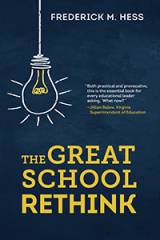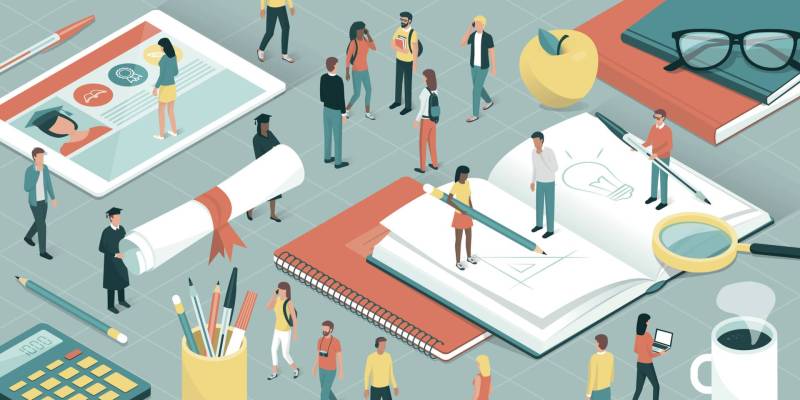Schools operated as buildings that provided a sprawling array of services to students who lived in a geographic area. It made sense, but was also a lot to ask. After all, it’s hard for any organization to do many different things, much less do them all well. Advances in technology have made it so that schools no longer need be one-stop shops for everything. It’s now possible for students to access books, tutoring, courses and even telehealth online, creating an extraordinary opening to ask how schools should be organized.
Today, school staff have to juggle all manner of tasks. Being a “teacher” means being an evaluator, remediator, lesson designer, hallway monitor, counselor, computer troubleshooter, secretary, coffeemaker and more. Maybe it doesn’t have to be this way. Are there better ways to organize the work that schools and teachers do, so as to empower educators while making their jobs more manageable? A good way to think about this is as “unbundling,” as in whether it’s possible to tease apart the many tasks schools have bundled together and then assemble them in more fruitful ways.22 This means asking what schools and educators should do by themselves, or when and how they might be better off tapping today’s vibrant ecosystem of nonschool resources and programs. Instead of lamenting how much schools and teachers are expected to do today, Rethinkers ask what we should expect them to do.
Take Personalization Seriously
Education is full of flowery talk about personalization. That’s fine. I sure don’t know anyone who says, “Schools should be less personal and more industrial.” In practice, though, school improvement efforts billed as “personalized” can have the opposite effect.
Remember that annual state testing was promoted, in part, as a way to be sure that individual students didn’t get overlooked. Yet the biggest complaint about annual assessment may be the way it can turn schools into impersonal test-prep factories. Education technology is touted as a tool of radical personalization. Yet, as we saw during the pandemic, remote instruction and classrooms of tablet-fixated kids can too easily feel dreary and soulless.
Giving students a Chromebook or an iPad is not personalization. The personalization resides in how these tools are used. Think of it this way: 50 years ago, if you wanted to listen to your favorite song, you’d buy a record, go home, put it on your record player and listen to the album one side at a time. The same applied to every person who wanted to hear that song. Personalizing your music wasn’t easy. Digital music technology has changed all that. Today, any listener has easy access to intricate algorithms that pick among millions of songs to create customized playlists that reflect personal preferences.
In education, personalization requires asking how tools and policies can be used to meet the varied needs of every learner. Expanded choices can better allow students at a given school to access courses, instructors, and programs that would otherwise be unavailable. New options may make it possible for bullied students to find a healthier, more welcoming environment or for parents to work more closely with their child on an array of school assignments. New technologies can allow one-size-fits-all curricula to be reconceived as more individualized playlists. But moving any of this from theory to practice is no easy thing.
Know What Problem You’re Solving
Education has a “fire, ready, aim” problem. Fueled by the high hopes of advocates and the expectation that every new superintendent will show up with novel solutions, education cycles through scads of reforms at an alarming pace. This makes it tough to be sure that the proposed fix is a good match for the problem — or even that we know exactly what the problem is.
Before leaping on some new program or practice, rethinkers first seek to define the problem they’re trying to solve. Anything else can do more harm than good, with the serial embrace of reflexive solutions turning into a convenient distraction from the real work at hand.
When I talk about distractions, I’m thinking of the district that moved to digital textbooks and a digital curriculum before ensuring that the devices would work as needed. The superintendent got cheered as an innovator, but students and teachers wound up worse off. Books and resources took forever to load, turning 10-minute assignments into marathon sessions. Kids found it tough to do homework on the bus or on the way to soccer since they couldn’t get reliable access to online assignments. And that’s all separate from the frustrations of teachers who struggled with glitchy portals and forgotten passwords. The heralded “solution” created more problems than it solved.
A new SEL initiative might help if middle schoolers are disengaged, but probably not if their disinterest is due to confusing math instruction. Knowing whether an intervention will help requires knowing what the problem is. Which kids are struggling? Why? How do we know? Be skeptical of those who offer surefire solutions before getting those answers. Programs and policies should be the final step of rethinking, not the first.
 Don’t get me wrong. Hard work matters. Careful execution matters. Elbow grease matters. But, if we think about that sandcastle, the big problem is that the kids are building it in the wrong spot. If they paused and moved 20 feet up the beach, the exact same effort would deliver a much more satisfying result.
Don’t get me wrong. Hard work matters. Careful execution matters. Elbow grease matters. But, if we think about that sandcastle, the big problem is that the kids are building it in the wrong spot. If they paused and moved 20 feet up the beach, the exact same effort would deliver a much more satisfying result.


 Frederick M. Hess
Frederick M. Hess